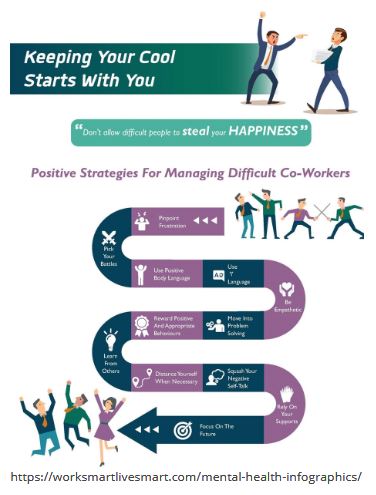Difficult people defy logic. Some are blissfully unaware of the negative impact that they have on those around them, and others seem to derive satisfaction from creating chaos and pushing other people’s buttons. Either way, they create unnecessary complexity, strife and worst of all stress.
Studies have long shown that stress can have a lasting, negative impact on the brain. Exposure to even a few days of stress compromises the effectiveness of neurons in the hippocampus — an important brain area responsible for reasoning and memory. Weeks of stress cause reversible damage to neuronal dendrites (the small “arms” that brain cells use to communicate with each other), and months of stress can permanently destroy neurons. Stress is a formidable threat to your success — when stress gets out of control, your brain and your performance suffer.
Most sources of stress at work are easy to identify. If your non-profit is working to land a grant that your organization needs to function, you’re bound to feel stress and likely know how to manage it. It’s the unexpected sources of stress that take you by surprise and harm you the most.
Recent research from the Department of Biological and Clinical Psychology at Friedrich Schiller University in Germany found that exposure to stimuli that cause strong negative emotions — the same kind of exposure you get when dealing with difficult people — caused subjects’ brains to have a massive stress response. Whether it’s negativity, cruelty, the victim syndrome or just plain craziness, difficult people drive your brain into a stressed-out state that should be avoided at all costs.
The ability to manage your emotions and remain calm under pressure has a direct link to your performance. TalentSmart has conducted research with more than a million people, and we’ve found that 90 percent of top performers are skilled at managing their emotions in times of stress in order to remain calm and in control. One of their greatest gifts is the ability to neutralize difficult people. Top performers have well-honed coping strategies that they employ to keep difficult people at bay.
While I’ve run across numerous effective strategies that smart people employ when dealing with difficult people, what follows are some of the best. To deal with difficult people effectively, you need an approach that enables you, across the board, to control what you can and eliminate what you can’t. The important thing to remember is that you are in control of far more than you realize.
1. They set limits.
Complainers and negative people are bad news because they wallow in their problems and fail to focus on solutions. They want people to join their pity party so that they can feel better about themselves. People often feel pressure to listen to complainers because they don’t want to be seen as callous or rude, but there’s a fine line between lending a sympathetic ear and getting sucked into their negative emotional spiral.
You can avoid this only by setting limits and distancing yourself when necessary. Think of it this way: if the complainer were smoking, would you sit there all afternoon inhaling the second-hand smoke? You’d distance yourself, and you should do the same with complainers. A great way to set limits is to ask complainers how they intend to fix the problem. They will either quiet down or redirect the conversation in a productive direction.
2. They rise above.
Difficult people drive you crazy because their behavior is so irrational. Make no mistake about it; their behavior truly goes against reason. So why do you allow yourself to respond to them emotionally and get sucked into the mix? The more irrational and off-base someone is, the easier it should be for you to remove yourself from their traps. Quit trying to beat them at their own game. Distance yourself from them emotionally and approach your interactions like they’re a science project (or you’re their shrink, if you prefer the analogy). You don’t need to respond to the emotional chaos — only the facts.
3. They stay aware of their emotions.
Maintaining an emotional distance requires awareness. You can’t stop someone from pushing your buttons if you don’t recognize when it’s happening. Sometimes you’ll find yourself in situations where you’ll need to regroup and choose the best way forward. This is fine and you shouldn’t be afraid to buy yourself some time to do so.
Think of it this way — if a mentally unstable person approaches you on the street and tells you he’s John F. Kennedy, you’re unlikely to set him straight. When you find yourself with a coworker who is engaged in similarly derailed thinking, sometimes it’s best to just smile and nod. If you’re going to have to straighten them out, it’s better to give yourself some time to plan the best way to go about it.
4. They establish boundaries.
This is the area where most people tend to sell themselves short. They feel like because they work or live with someone, they have no way to control the chaos. This couldn’t be further from the truth. Once you’ve found your way to Rise Above a person, you’ll begin to find their behavior more predictable and easier to understand. This will equip you to think rationally about when and where you have to put up with them and when you don’t. For example, even if you work with someone closely on a project team, that doesn’t mean that you need to have the same level of one-on-one interaction with them that you have with other team members.
You can establish a boundary, but you’ll have to do so consciously and proactively. If you let things happen naturally, you are bound to find yourself constantly embroiled in difficult conversations. If you set boundaries and decide when and where you’ll engage a difficult person, you can control much of the chaos. The only trick is to stick to your guns and keep boundaries in place when the person tries to encroach upon them, which they will.
5. They don’t die in the fight.
Smart people know how important it is to live to fight another day, especially when your foe is a toxic individual. In conflict, unchecked emotion makes you dig your heels in and fight the kind of battle that can leave you severely damaged. When you read and respond to your emotions, you’re able to choose your battles wisely and only stand your ground when the time is right.
6. They don’t focus on problems — only solutions.
Where you focus your attention determines your emotional state. When you fixate on the problems you’re facing, you create and prolong negative emotions and stress. When you focus on actions to better yourself and your circumstances, you create a sense of personal efficacy that produces positive emotions and reduces stress.
When it comes to toxic people, fixating on how crazy and difficult they are gives them power over you. Quit thinking about how troubling your difficult person is, and focus instead on how you’re going to go about handling them. This makes you more effective by putting you in control, and it will reduce the amount of stress you experience when interacting with them.
7. They don’t forget.
Emotionally intelligent people are quick to forgive, but that doesn’t mean that they forget. Forgiveness requires letting go of what’s happened so that you can move on. It doesn’t mean you’ll give a wrongdoer another chance. Smart people are unwilling to be bogged down unnecessarily by others’ mistakes, so they let them go quickly and are assertive in protecting themselves from future harm.
8. They squash negative self-talk.
Sometimes you absorb the negativity of other people. There’s nothing wrong with feeling bad about how someone is treating you, but your self-talk (the thoughts you have about your feelings) can either intensify the negativity or help you move past it. Negative self-talk is unrealistic, unnecessary and self-defeating. It sends you into a downward emotional spiral that is difficult to pull out of. You should avoid negative self-talk at all costs.
9. They get some sleep.
I’ve beaten this one to death over the years and can’t say enough about the importance of sleep to increasing your emotional intelligence and managing your stress levels. When you sleep, your brain literally recharges, so that you wake up alert and clear-headed. Your self-control, attention and memory are all reduced when you don’t get enough — or the right kind — of sleep. Sleep deprivation raises stress hormone levels on its own, even without a stressor present. A good night’s sleep makes you more positive, creative and proactive in your approach to toxic people, giving you the perspective you need to deal effectively with them.
10. They use their support system.
It’s tempting, yet entirely ineffective, to attempt tackling everything by yourself. To deal with toxic people, you need to recognize the weaknesses in your approach to them. This means tapping into your support system to gain perspective on a challenging person. Everyone has someone at work and/or outside work who is on their team, rooting for them and ready to help them get the best from a difficult situation. Identify these individuals in your life and make an effort to seek their insight and assistance when you need it. Something as simple as explaining the situation can lead to a new perspective. Most of the time, other people can see a solution that you can’t because they are not as emotionally invested in the situation.
Bringing It All Together
Before you get this system to work brilliantly, you’re going to have to pass some tests. Most of the time, you will find yourself tested by touchy interactions with problem people. Thankfully, the plasticity of the brain allows it to mold and change as you practice new behaviors, even when you fail. Implementing these healthy, stress-relieving techniques for dealing with difficult people will train your brain to handle stress more effectively and decrease the likelihood of ill effects.

Travis Bradberry
Award-winning co-author of the best-selling book, Emotional Intelligence 2.0, and the co-founder of TalentSmart — a consultancy that serves more than 75 percent of Fortune 500 companies and is a leading provider of emotional intelligence tests, training and certification.
His bestselling books have been translated into 25 languages and are available in more than 150 countries. Bradberry has written for, or been covered by, Newsweek, BusinessWeek, Fortune, USA Today, The Wall Street Journal, The Washington Post and the Harvard Business Review.





/about/multi-ethnic-businesspeople-arguing-78568172-57957f1d5f9b58173b2a5743.jpg)








 It seems that hardly a day goes by without some type of news about all that is going on with The Tonight Show on NBC. It amazes me that these are professionals who should know better, but they continue to make some very simple mistakes that come with a lot of consequence.
It seems that hardly a day goes by without some type of news about all that is going on with The Tonight Show on NBC. It amazes me that these are professionals who should know better, but they continue to make some very simple mistakes that come with a lot of consequence.